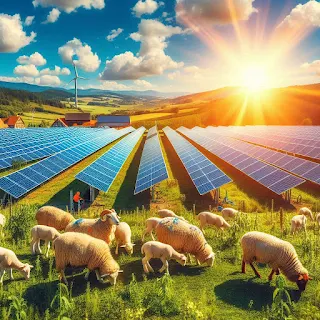The growing need for clean energy has brought forth innovative solutions that merge technology with nature. One such solution is solar sheep grazing—a practice that uses sheep to manage vegetation under and around solar panels. According to a two-year study by the American Solar Grazing Association, this method has proven to create a beneficial dual-use environment, supporting both renewable energy generation and agricultural productivity.
What Is Solar Sheep Grazing?
A Dual-Use Concept
Solar sheep grazing is a practice where sheep are allowed to graze on solar farms, maintaining the grass and vegetation without the need for lawnmowers, herbicides, or human labor. This approach creates a symbiotic relationship between livestock management and solar power production.
Why Sheep?
Sheep are uniquely suited for this role because:
They don’t climb on or damage solar panels.
They thrive on diverse vegetation, making them excellent landscapers.
They are low-maintenance compared to other livestock.
Key Findings from the Study
The American Solar Grazing Association (ASGA) conducted research at 31 solar sites over two years. The findings showed:
Improved vegetation management without the use of chemicals or machines.
Reduced fire hazards due to consistent grazing.
Enhanced soil health from natural fertilization.
Higher land-use efficiency, with energy and agriculture coexisting.
Environmental and Economic Benefits
1. Reduced Carbon Footprint
Grazing sheep eliminate the need for fossil-fuel-powered mowers and reduce carbon emissions related to landscape maintenance.
2. Cost Savings for Solar Developers
Developers can save on operational costs while keeping vegetation under control.
3. New Revenue Streams for Farmers
Farmers can lease their sheep to solar operators or access grazing lands, diversifying income.
Challenges and Considerations
While promising, this practice is not without challenges:
Proper fencing and protection from predators is necessary.
Coordinated grazing schedules are required to avoid overgrazing.
Not all climates or regions are suitable for year-round grazing.
The Future of Agrivoltaics
Solar sheep grazing is part of a larger movement known as agrivoltaics, which seeks to combine agriculture and photovoltaics for mutual benefit. As land becomes more scarce, dual-use solutions like this could redefine rural land management.
Governments and energy developers are beginning to take notice, with policy initiatives and pilot programs launching in the U.S., Europe, and Australia.
Conclusion
The integration of sheep grazing with solar energy production is more than a clever land management strategy—it's a symbol of how renewable energy can harmonize with nature. By making solar farms more sustainable and productive, solar sheep grazing offers a win-win for clean energy and agriculture.


No comments:
Post a Comment